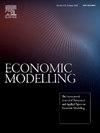Productive demand and sectoral capacity utilization
IF 4.7
2区 经济学
Q1 ECONOMICS
引用次数: 0
Abstract
The Solow residual, often used to measure technological progress, also reflects fluctuations in input utilization and related factors. We develop a multisector model decomposing capacity utilization into shopping-effort and variable capital intensity components, attributing sectoral Solow residual variation to utilization, technology, and input share mismeasurement. Using Bayesian estimation with capacity utilization data from nondurable and durable goods sectors, we identify key parameters governing goods market frictions. We find that search demand shocks explain most forecast error variance in the Solow residual, output, and utilization. Together with matching frictions, these shocks are essential for replicating observed sectoral dynamics, including volatility, correlations, and autocorrelations of utilization rates. Impulse response analysis reveals that demand shocks uniquely generate three-way comovement among utilization rates and the Solow residual.
生产需求和部门产能利用率
通常用来衡量技术进步的索洛剩余也反映了投入利用率和相关因素的波动。我们开发了一个多部门模型,将产能利用率分解为购物努力和可变资本强度组成部分,将部门索洛剩余变化归因于利用率、技术和投入份额的误判。使用贝叶斯估计和来自非耐用品和耐用品部门的产能利用率数据,我们确定了控制商品市场摩擦的关键参数。我们发现搜索需求冲击解释了索洛残差、产出和利用率的大部分预测误差方差。与匹配摩擦一起,这些冲击对于复制观察到的行业动态至关重要,包括波动性、相关性和利用率的自相关性。脉冲响应分析表明,需求冲击独特地产生了利用率和索洛剩余量之间的三方运动。
本文章由计算机程序翻译,如有差异,请以英文原文为准。
求助全文
约1分钟内获得全文
求助全文
来源期刊

Economic Modelling
ECONOMICS-
CiteScore
8.00
自引率
10.60%
发文量
295
期刊介绍:
Economic Modelling fills a major gap in the economics literature, providing a single source of both theoretical and applied papers on economic modelling. The journal prime objective is to provide an international review of the state-of-the-art in economic modelling. Economic Modelling publishes the complete versions of many large-scale models of industrially advanced economies which have been developed for policy analysis. Examples are the Bank of England Model and the US Federal Reserve Board Model which had hitherto been unpublished. As individual models are revised and updated, the journal publishes subsequent papers dealing with these revisions, so keeping its readers as up to date as possible.
 求助内容:
求助内容: 应助结果提醒方式:
应助结果提醒方式:


